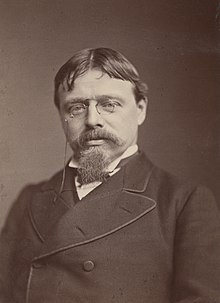 Sir Lawrence Alma-Tadema OM RA (/ˈælmə ˈtædɪmə/; born Lourens Alma Tadema [ˈlʌurəns ˈɑlmaː ˈtaːdəˌmaː]; 8 January 1836 – 25 June 1912) was a Frisian painter of special British denizenship.
Sir Lawrence Alma-Tadema OM RA (/ˈælmə ˈtædɪmə/; born Lourens Alma Tadema [ˈlʌurəns ˈɑlmaː ˈtaːdəˌmaː]; 8 January 1836 – 25 June 1912) was a Frisian painter of special British denizenship.Born in Dronrijp, the Netherlands, and trained at the Royal Academy of Antwerp, Belgium, he settled in England in 1870 and spent the rest of his life there. A classical-subject painter, he became famous for his depictions of the luxury and decadence of the Roman Empire, with languorous figures set in fabulous marbled interiors or against a backdrop of dazzling blue Mediterranean Sea and sky.
Though admired during his lifetime for his draftsmanship and depictions of Classical antiquity, his work fell into disrepute after his death, and only since the 1960s has it been re-evaluated for its importance within nineteenth-century English art.
After his arrival in England, where he was to spend the rest of his life, Alma-Tadema's career was one of continued success...
He became one of the most famous and highly paid artists of his time, acknowledged and rewarded. By 1871 he had met and befriended most of the major Pre-Raphaelite painters and it was in part due to their influence that the artist brightened his palette, varied his hues, and lightened his brushwork.
In 1872 Alma-Tadema organised his paintings into an identification system by including an opus number under his signature and assigning his earlier pictures numbers as well. Portrait of my sister, Artje, painted in 1851, is numbered opus I, while two months before his death he completed Preparations in the Coliseum, opus CCCCVIII. Such a system would make it difficult for fakes to be passed off as originals.[16]
In 1873 Queen Victoria in Council by letters patent made Alma-Tadema and his wife what are now the last British Denizens (the legal process has theoretically not yet been abolished in the United Kingdom), with some limited special rights otherwise only accorded to and enjoyed by British subjects (what would now be called British citizens). The previous year he and his wife made a journey on the Continent that lasted five and a half months and took them through Brussels, Germany, and Italy. In Italy they were able to take in the ancient ruins again; this time he purchased several photographs, mostly of the ruins, which began his immense collection of folios with archival material sufficient for the documentation used in the completion of future paintings. In January 1876, he rented a studio in Rome. The family returned to London in April, visiting the Parisian Salon on their way back. In London he regularly met with fellow-artist Emil Fuchs.[17][18]
Among the most important of his pictures during this period was An Audience at Agrippa's (1876). When an admirer of the painting offered to pay a substantial sum for a painting with a similar theme, Alma-Tadema simply turned the emperor around to show him leaving in After the Audience.
On 19 June 1879, Alma-Tadema was made a full Academician, his most personally important award. Three years later a major retrospective of his entire oeuvre was organised at the Grosvenor Gallery in London, including 185 of his pictures.
In 1883 he returned to Rome and, most notably, Pompeii, where further excavations had taken place since his last visit. He spent a significant amount of time studying the site, going there daily. These excursions gave him an ample source of subject matter as he began to further his knowledge of daily Roman life. At times, however, he integrated so many objects into his paintings that some said they resembled museum catalogues.
One of his most famous paintings is The Roses of Heliogabalus (1888) – based on an episode from the life of the debauched Roman Emperor Elagabalus (Heliogabalus), the painting depicts the psychopathic Emperor suffocating his guests at an orgy under a cascade of rose petals. The blossoms depicted were sent weekly to the artist's London studio from the Riviera for four months during the winter of 1887–1888.
Among Alma-Tadema's works of this period are: An Earthly Paradise (1891), Unconscious Rivals (1893) Spring (1894), The Coliseum (1896) and The Baths of Caracalla (1899). Although Alma-Tadema's fame rests on his paintings set in Antiquity, he also painted portraits, landscapes and watercolours, and made some etchings himself (although many more were made of his paintings by others).
Lawrence Alma-Tadema select paintings:









